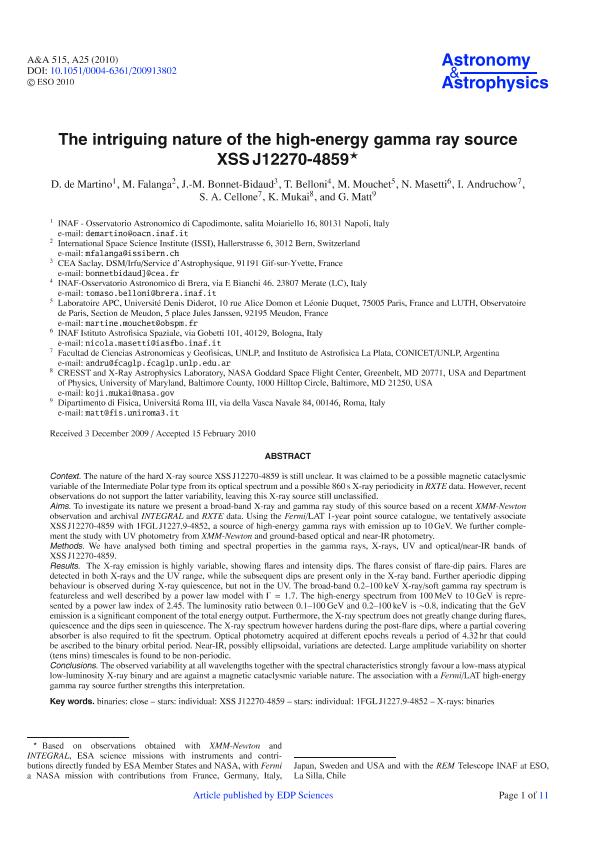Artículo
The intriguing nature of the high-energy gamma ray source XSS J12270-4859
De Martino, D.; Falanga, M.; Bonnet-Bidaud, J.-M.; Belloni, T.; Mouchet, M.; Masetti, N.; Andruchow, Ileana ; Cellone, Sergio Aldo
; Cellone, Sergio Aldo ; Mukai, K.; Matt, G.
; Mukai, K.; Matt, G.
 ; Cellone, Sergio Aldo
; Cellone, Sergio Aldo ; Mukai, K.; Matt, G.
; Mukai, K.; Matt, G.
Fecha de publicación:
06/2010
Editorial:
EDP Sciences
Revista:
Astronomy and Astrophysics
ISSN:
0004-6361
Idioma:
Inglés
Tipo de recurso:
Artículo publicado
Clasificación temática:
Resumen
The nature of the hard X-ray source XSS J12270-4859 is still unclear. It was claimed to be a possible magnetic Cataclysmic Variable of the Intermediate Polar type from its optical spectrum and a possible 860 s X-ray periodicity in RXTE data. However, recent observations do not support the latter variability, leaving this X-ray source still unclassified. To investigate its nature we present a broad-band X-ray and gamma ray study of this source based on a recent XMM-Newton observation and archival INTEGRAL and RXTE data. Using the Fermi/LAT 1-year point source catalogue, we tentatively associate XSS J12270-4859 with 1FGL J1227.9-4852, a source of high energy gamma rays with emission up to 10 GeV. We further complement the study with UV photometry from XMM-Newton and ground-based optical and near-IR photometry. We have analysed both timing and spectral properties in the gamma rays, X-rays, UV and optical/near-IR bands of XSS J12270-4859. The X-ray emission is highly variable showing flares and intensity dips. The flares consist of flare-dip pairs. Flares are detected in both X-rays and UV range whilst the subsequent dips are present only in the X-ray band. Further aperiodic dipping behaviour is observed during X-ray quiescence but not in the UV. The broad-band 0.2--100 keV X-ray/soft gamma ray spectrum is featureless and well described by a power law model with Gamma=1.7. The high energy spectrum from 100 MeV to 10 GeV is represented by a power law index of 2.45. The luminosity ratio between 0.1--100 GeV and 0.2--100 keV is ~ 0.8, indicating that the GeV emission is a significant component of the total energy output. Furthermore, the X-ray spectrum does not greatly change during flares, quiescence and the dips seen in quiescence. The X-ray spectrum however hardens during the post-flare dips, where a partial covering absorber is also required to fit the spectrum. Optical photometry acquired at different epochs reveals a period of 4.32 hr that could be ascribed to the binary orbital period. Near-IR, possibly ellipsoidal, variations are detected. Large amplitude variability on shorter (tens mins) timescales are found to be non-periodic. The observed variability at all wavelengths together with the spectral characteristics strongly favour a low-mass atypical low-luminosity X-ray binary and are against a magnetic Cataclysmic Variable nature. The association with a Fermi/LAT high energy gamma ray source further strengths this interpretation.
Archivos asociados
Licencia
Identificadores
Colecciones
Articulos(IALP)
Articulos de INST.DE ASTROFISICA LA PLATA
Articulos de INST.DE ASTROFISICA LA PLATA
Citación
De Martino, D.; Falanga, M.; Bonnet-Bidaud, J.-M.; Belloni, T.; Mouchet, M.; et al.; The intriguing nature of the high-energy gamma ray source XSS J12270-4859; EDP Sciences; Astronomy and Astrophysics; 515; 6-2010; 25-36
Compartir
Altmétricas



